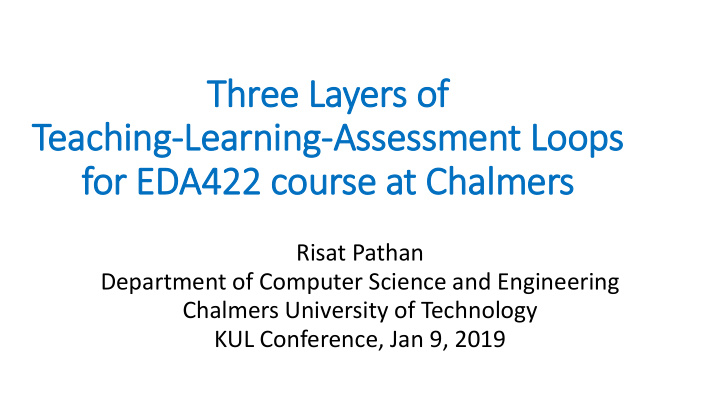



Thr hree L Layer ers of of Teac eaching-Learn rning-Assessm ssment Loop oops for or EDA422 c 422 cou ourse a at Cha halmers Risat Pathan Department of Computer Science and Engineering Chalmers University of Technology KUL Conference, Jan 9, 2019
The purpose of my talk… Present the structure of EDA422 course at Chalmers “EDA422: Parallel and Distributed Real-Time Systems”
The t e tea each ching-lear arning-assessment l loop… and and the he feedbac dback Teaching (lecture, consultation, tutorials) Feedback Learning Yearly: course evaluation (study, problem solving, field trip) Email, conversation, etc. Assessment (exams, homework, lab reports)
Feedb eedback ck: Is f final c cou ourse e e evalua uation eno enough? • Not really because Final course evaluation does not answer “How to shape a specific lecture?” Students who provide the feedback are not benefitted Many students do not even answer Additional mechanisms are needed to get continuous feedback To receive continuous feedback from the students, the EDA422 course has three teaching-learning- assessment-feedback loops
Th Three t teach eaching-learni ning ng-as asses essmen ent-feedback l ack loops o of EDA422 c course • Loop1: Daily lecture and short quiz • Loop2: Weekly consultation sessions for monthly take-home exam • Loop3: Monthly oral exam on take-home exam solution I will explain these three loops that help (i) constructive and continuous alignment, and (ii) intense student-student and student-teacher interactions to achieve the learning outcomes of the course
Loop1: Daily lecture and short quiz Teaching (lecture slides) Learning Daily Feedback (Positive question, (Right concept, Negative question, Wrong concept, Ask the next step) Missing concept) Assessment (~5 mins quiz at the end)
Lo Loop1: : Feedi ding bac back k to ne o next l lecture In next lecture, I correct their wrong and missing concepts • No misconception propagates to next lecture • Align the next quiz based on such concepts • Since there is a quiz every lecture, they become relatively • more interactive to learn the right concept I need to spend approx. an hour to check around 25 short quizzes
Loo oop2: 2: Weekly consu sultation s ses ession f for t take-hom ome e exam Teaching (Prepare take-home exams, Schedule weekly consultation) Learning Weekly Feedback (Who needs more help, common (apply theory, analyze, prove/disprove, wrong approach) mistakes, problem statements) Assessment (~3 weeks: a written solution of the take-home exams)
Loop2: Feeding back from weekly consultations Redesign next lecture to cover critical concepts that most • students are struggling with Help me to identify weaker students and offer them more • help during next consultation Make the take-home exam questions clearer next year • The consultation session is highly student-student and • student-teacher interactive
Loop3: Mon onthly or y oral e exams on t on tak ake-hom ome e e exam am s sol olution ons Teaching Prepare Oral Exam Schedule (Read the solutions, preliminary points) Learning Monthly feedback (Prepare argument, why the (attaining learning outcomes, solution is better, alternative) what approach they have used) Assessment (1 hour: present their argument, solve new scenarios)
Loop3: F Feedi ding bac back k from or oral e exam ams Adjust the assigned deadline and level of difficulty of the • take-home exams Approach by the students to tackle open research problems • that I set in the take-home exam Approach by the students to tackle completely new problem • that I ask them to solve during the oral exam Redesign some lectures for next year •
Recall the purpose of my talk… Present the structure of EDA422 course at Chalmers
The three layers of loops… Quiz Consultation Quiz Quiz Quiz Oral Consultation Exam Quiz Quiz Quiz Quiz Consultation Quiz
Overall Idea of teaching the EDA422 course • I try to keep the lectures relatively easy , with short quiz • Provide a lot of industry related examples, use cases • Problems on the take-home exams are more challenging • Open research problems from my domain of research • By applying the knowledge from lectures and by reading published articles they solve the take-home exams • Think critically to defend their solutions for oral exams
Conclusion • Getting continuous feedback during the course helps to achieve the learning outcome of the course • Intense student-student and student-teacher interactions by having three layers of teaching- learning activities • One take-away message: Frequent (per lecture) in- class quiz in EDA422 course is effective
THANK YOU
Recommend
More recommend